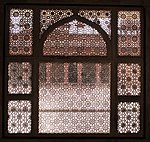Salim Chishti

Salim Chishti or Salim Chisti ( Hindi सलीम चिश्ती , Urdu سلیم چشتی; * 1478 or 1480 in probably Delhi ; † 1572 in Fatehpur Sikri ) was a Sufi of the Islamic Chishtiyya order that originated in Afghanistan and represented a comparatively tolerant interpretation of the Koran .
biography
Sheikh Salim Chishti came from an influential Muslim family from Delhi . As a man, he made several pilgrimages to the holy places of Mecca and Medina and spent a total of more than 20 years in Arabia and the Middle East. In 1564, at the age of over 80, he settled in the barren and rocky area of Sikri, about 40 km southwest of Agra , where he soon enjoyed a reputation among locals and foreigners as a wise and miraculous man. His reputation reached up to the Mughal Emperor Akbar I , who - despite several wives - was still without a male heir to the throne and visited him in 1568 and received the most urgently hoped for prophecy that he would soon be the father of three sons - the first, Prince Salim, the later Mughal ruler Jahangir (ruled 1605–1627) was born to him the following year by the Hindu princess Mariam uz-Zamani ; two more sons from other women followed. For various reasons Akbar decided to found a new capital near the revered Sufi saint, to which he named 'Fatehpur Sikri'. Large parts of the palace were already completed in 1571 and he moved here. The holy man died the following year, but his veneration continues to this day.
mausoleum
The Salim Chishtis mausoleum , which was built under Akbar and was initially just a simple mausoleum, stands in the courtyard of the Friday mosque of Fatehpur Sikri. It was renewed under the Great Mughals Jahangir and Shah Jahan (ruled 1627–1658) and is provided with the finest marble grids ( jalis ) and colored stone incrustations in the base zone. In addition, the building is adorned with serpentine support elements, which - like the flat-roofed portal and corridor area - are obviously borrowed from Hindu temple architecture . Under a central dome is the cenotaph of the saint, always covered with colored cloths . Women of all religions tie colored threads of fabric to the Jali lattice and thus express their admiration and their wish for the birth of a son.
Others
The house ( Khanqah ) of Salim Chishtis stands just outside the palace district of Fatehpur Sikri; it is probably the oldest surviving structure on site.
literature
- Bamber Gascoigne: The Mughals. Splendor and greatness of Mohammedan princes in India. Callwey, Munich 1987, ISBN 3-570-09930-X , p. 91f.
Web links
- House Salim Chishtis - Photos + Info (English)
| personal data | |
|---|---|
| SURNAME | Chishti, Salim |
| ALTERNATIVE NAMES | Chisti, Salim; सलीम चिश्ती (hiS); سلیم چشتی (urS) |
| BRIEF DESCRIPTION | Sufi of the Islamic Chishtiyya order that originated in Afghanistan |
| DATE OF BIRTH | 1478 or 1480 |
| PLACE OF BIRTH | unsure: Delhi |
| DATE OF DEATH | 1572 |
| Place of death | Fatehpur Sikri |

